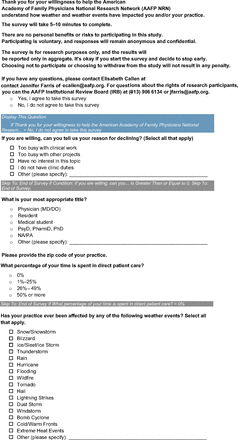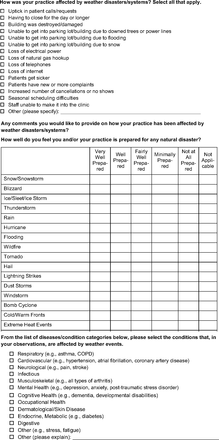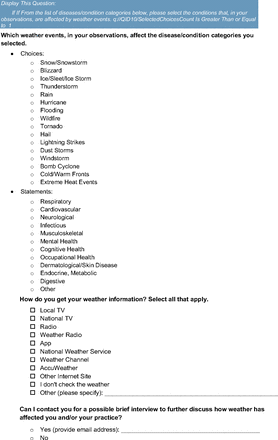Abstract
Background: When we consider weather impacts, we mainly consider how the event affects the person, not the clinicians treating them. There is a paucity of studies discussing the effect of weather on the clinicians and the care of their patients.
Methods: A survey covering weather effects was distributed to American Academy of Family Physicians National Research Network (AAFP NRN) members in August 2020. Descriptive statistics and Fisher’s exact tests were completed on the survey responses. Postsurvey interviews were conducted with selected respondents about specific weather events.
Results: Survey respondents were US physicians (88.7%) and 84.9% indicated more than 1 type of event has affected their practice. Respondents were most affected by snow/snowstorm (81.1%) and indicated they had to close for the day or longer and staff were unable to make it into clinic (79.2%). Respondents indicated respiratory (94.5%), mental health (81.8%), and musculoskeletal conditions (50.9%) were most affected by weather. Interviews with selected respondents covered weather topics including winter, summer, and flooding.
Discussion: Survey respondents/interviewees indicated weather affects them in a variety of ways including issues with patients’ conditions and practice effects. Clinicians have noticed a change to their areas’ weather over the years, but, generally, warming is occurring.
Introduction
When we think about weather and the effect on people, we consider how the person is affected and not the clinicians treating them. Numerous studies explore weather effects on people including extreme heat1⇓⇓⇓⇓⇓⇓⇓⇓⇓–11; excess deaths with cold weather1,4,7,11⇓–13; changes in pressure and temperature,14⇓⇓⇓⇓⇓⇓⇓⇓⇓–24 among others.25⇓⇓⇓⇓–30 Additional studies detail how patients with asthma,28,31⇓–33 COPD,34⇓–36 arthritis,23,37,38 and other conditions9,39⇓–41 are affected by weather. Conversely, there are also studies questioning weather’s impact on patients.42,43
Studies discussing the impact on clinicians are rare. However, studies provide ideas and principles for practices, clinicians, and societies for coping with extreme weather,44⇓⇓–47 adapting to climate change,47⇓–49 and coping with weather challenges.50⇓–52 The biggest weather impacts on practices are still relatively unknown, which led to investigating how weather affects primary care clinicians, their practices, and their patient panel. Survey respondents were differentiated by regional location and time in patient care.
Methods
This study seeks to address gaps in knowledge about how clinicians react to weather in their area. To achieve this, a survey was sent to American Academy of Family Physicians National Research Network (AAFP NRN) members and selected AAFP NRN members were interviewed. This study was approved by the AAFP Institutional Review Board.
Survey Instrument and Administration
The survey instrument was constructed based on our knowledge of weather and potential related disruptions. Survey questions included demographics, weather types, and ways practices and patients were impacted. Most AAFP NRN members are primary care clinicians in the US. The survey was built and distributed in Qualtrics (Provo, Utah). Respondents could proceed to the survey only after acknowledging the Informed Consent on the first page. The survey had no back button, 5 pages, 12 questions, and no incentive (Appendix).
The initial invite went out July 30, 2020, with a reminder on August 12, 2020, and closing September 14, 2020. The survey was distributed to every person in the AAFP NRN database (1584 active e-mails) who had previously consented to receiving surveys.
Interviews
Within the survey, 1 question asked the respondents if they would be willing to participate in an interview. Out of 16 people who agreed, 9 responded to further contact. The interview questions (Appendix) were derived based on respondents’ answers to the survey. The first author conducted phone interviews lasting approximately 15 minutes each. They were conducted, recorded, and transcribed mid-August through mid-September 2020.
Analysis
Descriptive statistics were completed for all survey questions. We used all available data, assuming ignorable missingness. Fisher’s Exact Tests were completed using R53 in the survey analysis. For the interviews, the authors read the transcripts and determined themes from the interviewees’ responses.
Results
Survey Results
Of the 62 who at least partially completed the survey (response rate: 3.9%), 88.7% were physicians and the remaining 11.3% held other titles. Most respondents (61.3%) spent 50% or more of their time in direct patient care. The respondents’ practices were from across the US—30.6% from the South, 25.8% from the West, 24.2% from the Midwest, and 19.4% from the Northeast (Table 1).
Survey Respondent Demographics
Most respondents (84.9%) indicated that more than 1 type of weather event has affected their practice, the most common being snow/snowstorm (81.1%) regardless of time in patient care or region. Though snow/snowstorm affected practices equally, ice/sleet/ice storm did not. Although the majority (52.8%) indicated being affected by ice and time in patient care did not make a difference, the region did. Virtually all Midwest respondents (90.0%), and almost no West respondents (14.3%) were affected by ice (P = .001). Nearly half (40.0%) of Midwest respondents indicated lightning affected practices; Northeast and West respondents indicated no effect (0.0%; P = .009). Almost half (43.8%) with less and only 10.8% with more time in patient care indicated extreme heat events affect their practices (P = .011; Table 2).
Types of Weather Events That Have Affected Respondents’ Practices (n = 53)
Respondents indicated their practices were affected by weather with 79.2% had to close for the day or longer and staff were unable to make it in. Three-fourths (75.5%) had an increased number of cancellations or no shows. The respondents from the Midwest, Northeast, and South were more likely to be affected by loss of internet (70.0%, 66.7%, 64.7%, respectively) than the West (21.4%; P = .038) as well as loss of telephones (60.0%, 50.0%, 76.5%, 14.3%; P = .005) and electric power (40.0%, 50.0%, 70.6%, 7.1%; P = .003; Table 3).
Types of Effects from Weather Disasters/Systems That Have Affected Respondents’ Practices (n = 53)
Respondents were asked which diseases/conditions, in their opinion, were affected by weather. Most (94.5%) indicated respiratory conditions are affected, as well as 81.8% for mental health and 50.9% for musculoskeletal conditions. However, respondents with less time in patient care were more likely (22.2%) to indicate that digestive conditions were affected by weather than respondents with more time in patient care (2.7%; P = .035; Table 4).
Diseases/Conditions Affected by Weather Events (n = 55)
Qualitative Results
Winter
Clinicians were prepared by having services on-call to plow their parking lots, haul away snow if there is too much, and systems in place to inform patients of closures. A clinician in the South disclosed their city purchased a snowplow, but they get too much snow for 1 snowplow.
Summer
The main summer weather events the clinicians experienced were thunderstorms and heat. One clinician is in an area prone to wildfires and has noticed wildfires getting worse/more frequent in recent years. Houses in their area are being built with fire resistant materials.
Flooding
Although hurricanes were most discussed, 1 clinician mentioned flooding occurred when the snow melted quicker than normal, and drainage could not handle runoff. Another mentioned they live in a very flood-prone area, but their clinic sits on higher ground and is typically unaffected by flooding.
Specific Health Effects
Clinicians agreed that weather affects their patients. They noted trends in patient complaints depending on the time of year or there was a weather event. Clinicians mentioned not only the physical effects, but also mental outcomes including anxiety and seasonal affective disorder.
Power
Most clinicians interviewed do not have generators for their practices. A few mentioned they rarely lose power for more than a few hours, as they are part of the group to be restored first. One clinician mentioned they will close their practice until power is restored. A few commented that if power is lost, a designated person will take vaccines to someplace with power. They had lost thousands of dollars’ worth of vaccines due to power loss.
Telemedicine
Clinicians hoped telemedicine continues after the pandemic, because it is easier and more effective to meet with patients who cannot get out of their homes due to weather.
Weather Changes
Most clinicians interviewed mentioned they have seen changes occurring to their weather in the time they have lived in their respective locations (all more than 10 years). They mentioned changes in rain, for example, less rain/having to rely on the aquifer more; snow, for example, seeing less snow, more ice; and air quality. In addition, they expressed that it seems to be generally getting warmer.
Discussion
Clinicians indicated weather affects their patient population in a variety of ways, mainly by winter weather and rain events. This is in line with previous studies where patients were more likely to visit emergency rooms around snow54⇓⇓–57 and flooding.58⇓–60 Extreme heat affected all practices equally, but respondents who saw patients less stated more issues with extreme heat than those who saw more patients. This could be due to patient panels and practice location/type.
Weather events can cause disruptions, with the practice needing to close a day or longer or having an increase in cancellations or no-shows. However, Midwest respondents were more affected by loss of internet and Southern respondents had loss of telephones and electric power more than the other regions. These and other problems are expected to get worse as the climate changes and are suggested as possible items to fortify to adapt accordingly.44⇓⇓⇓⇓–49
Weather can also cause issues for the patients by triggering a flare in their respiratory conditions, affecting mental health, among other physical and mental effects. The effect of weather on people/patients is in line with other studies.1,5⇓⇓⇓⇓⇓⇓⇓⇓⇓⇓⇓⇓⇓⇓⇓⇓⇓⇓⇓⇓⇓–27,29⇓⇓⇓⇓⇓⇓⇓⇓⇓⇓⇓⇓⇓–43,54⇓⇓⇓⇓⇓–60
Interviewed clinicians have noticed a change to the weather in their areas over the years, and a pattern of warming. They also noted instances where they were not prepared, but then implemented processes to remedy the issues (eg, off-site refrigeration for vaccines). Further study is needed to understand the continued impact of weather on clinicians and the full effect of weather on a larger clinician population.
Although the response rate was low, it was in line with other surveys the AAFP NRN was conducting around the same time. We do understand the low response rate could affect the generalizability of the results. The response rate could be due to a lack of interest in the topic and the distribution during the COVID-19 pandemic. The voluntary nature of the survey may have introduced nonresponse bias. We endeavored to mitigate this by leaving the survey open for more than a month. An interview limitation was that they were asked to recall weather events from over the past several years.
Conclusion
Weather will continue to affect clinicians and practices. Although there are some resources and studies for weather related effects and how weather affects patients, further study is needed to determine the full effect on clinicians and practices and ways to mitigate effects of weather on practices.
Acknowledgments
Authors would like to thank the AAFP National Research Network members who participated in the survey and participated in the interviews and the AAFP NRN Senior staff for their support.
Appendix.Weather Survey



Notes
This article was externally peer reviewed.
Funding: There are no external funding sources for this study.
Conflict of interest: None.
Acknowledgements: The author would like to thank the AAFP National Research Network members who participated in the survey and participated in the interviews and the AAFP NRN Senior staff for their support.
To see this article online, please go to: http://jabfm.org/content/37/1/95.full.
- Received for publication March 29, 2023.
- Revision received April 11, 2023.
- Revision received June 14, 2023.
- Accepted for publication June 20, 2023.






